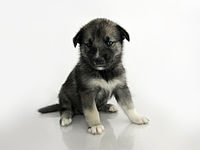
A puppy or pup is a juvenile dog, generally less than one year of age. It has not reached sexual maturity. Puppy size varies among breeds: smaller puppies may weigh 1–3 lb (0.45–1.4 kg), while others are 15–20 lb (6.8–9.1 kg). All healthy puppies grow rapidly after birth.
A puppy's coat color may change as the puppy matures, as is commonly seen in breeds such as the Yorkshire Terrier.
The number of puppies in a litter varies greatly by breed. Some smaller dogs bear only one or two puppies at a time, while some larger breeds bear ten or more. In some cases, one puppy will be the runt of the litter, being noticeably smaller than the other puppies. The runt is generally quite meek or very aggressive because of its size compared to its siblings.

Born after approximately 63 days of gestation, puppies emerge in an amnion which is bitten off and eaten by the mother dog.
Puppies begin to nurse almost immediately. If the litter exceeds six puppies, particularly if one or more are obvious runts, human intervention in hand-feeding the stronger puppies will be necessary to ensure that the runts get proper nourishment and attention from the mother to thrive. As they reach one month of age, the puppies are gradually weaned and begin to eat solid food. The mother may regurgitate partially digested food for the puppies to eat or might let them eat some of her solid food. By the age of about seven weeks, puppies no longer depend on nursing for food. Although they may continue trying to nurse, the mother dog may no longer allow them to after this age; still, she might let them occasionally nurse for comfort.
At first, puppies spend ninety percent of their time sleeping and the rest feeding. During their first two weeks, although it is not completely visible, a puppy's senses all develop rapidly. Puppies open their eyes about nine to eleven days following birth. At first, the retina is poorly developed and their vision is poor. Puppies are not able to see as well as adult dogs. In addition, puppies ears remain sealed until about thirteen to seventeen days after birth, after which they respond more actively to sounds. From two to four weeks, puppies usually begin to growl, bite, wag their tails, and bark.
Puppies develop very quickly during their first three months, particularly after their eyes and ears open and they are no longer completely dependent on their mother. Their coordination and strength improve, they spar with their litter-mates, and begin to explore the world outside the nest. They play wrestling, chase, dominance, and tug-of-war games.
Puppies are highly social animals and spend most of their waking hours interacting with either their mother or littermates. Most experts now believe that being with its mother and littermates until at least eight weeks is important for a puppy's behavioral development. Responsible breeders will not sell a puppy that is younger than eight to twelve weeks, and in many jurisdictions, it is illegal to give away puppies younger than a certain age (usually between eight and twelve weeks).
A litter of Australian Kelpie puppies
It is important that the puppy receive regular positive socialisation with other dogs and humans during the first sensitive period (eight to twelve weeks). Puppies should be exposed to as wide a variety of friendly people and dogs as possible during this period. Dogs that do not receive adequate socialization during the first sensitive period may display fearful behaviour around humans or dogs as adults. Males tend to be more hyperactive when they are young.(Wikipedia)




